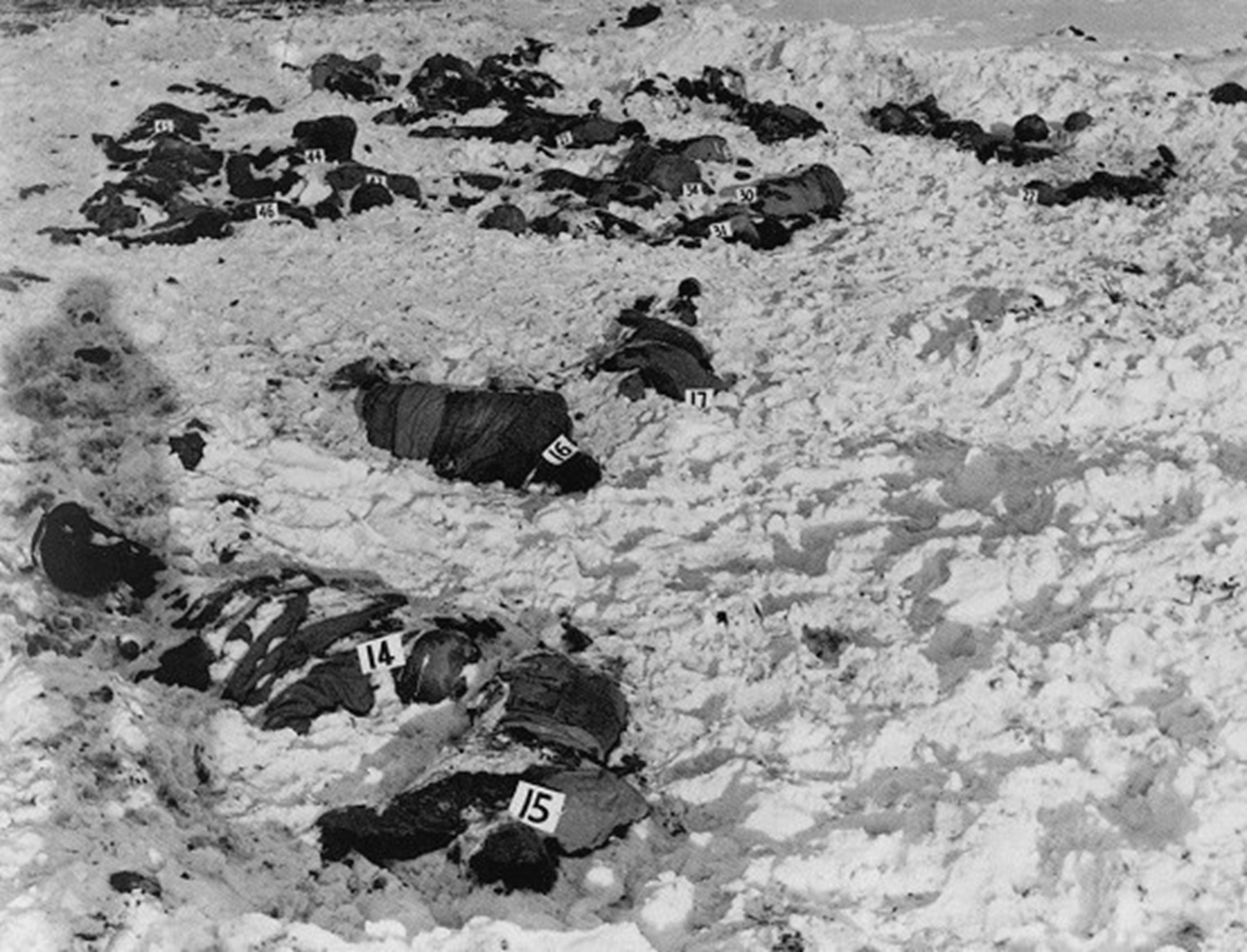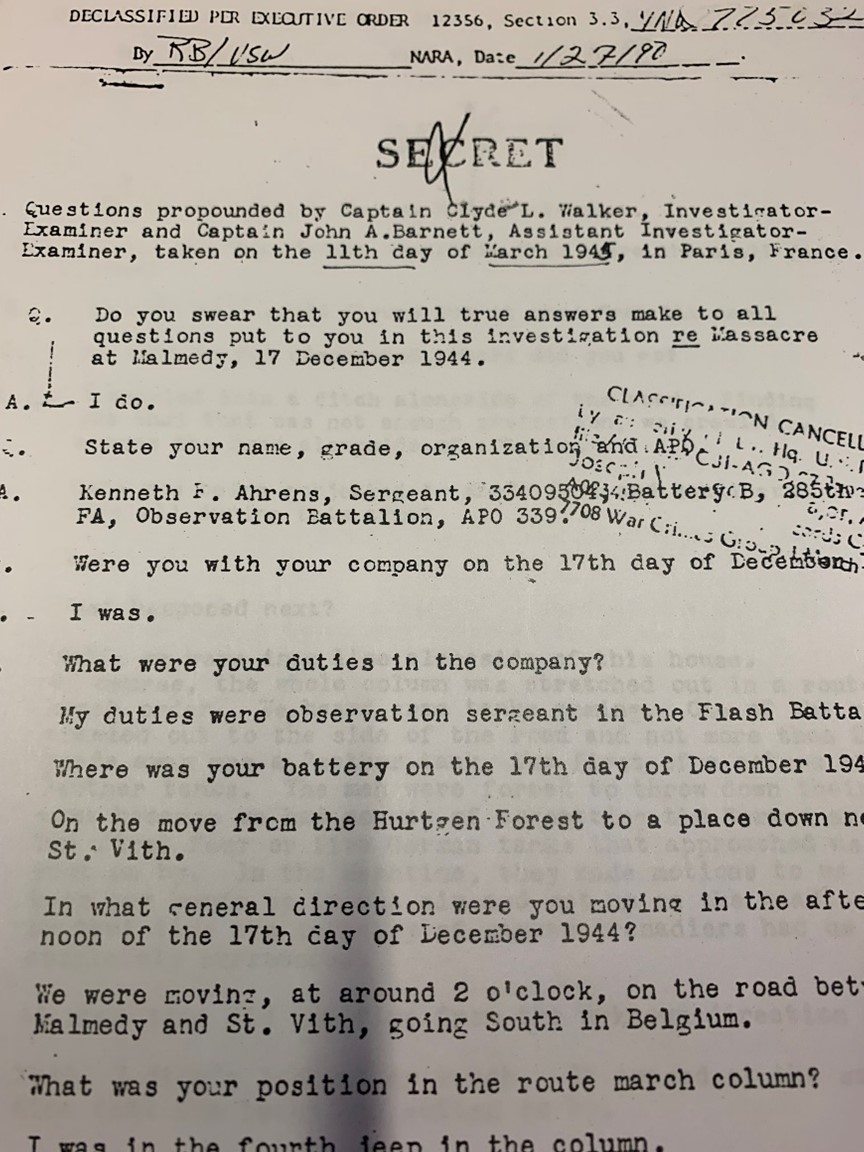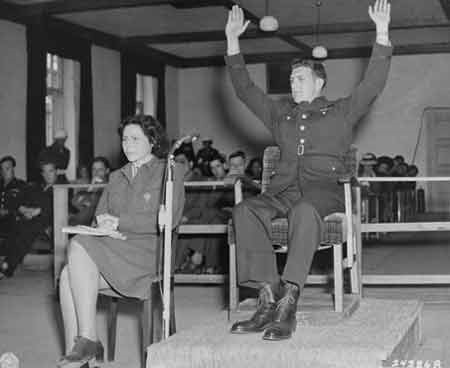On December 17, 1944, perhaps the most infamous war crime committed against American soldiers in World War II took place near the small Belgian town of Malmedy. An American artillery observation unit ran head on into a German SS Panzer unit. A brief firefight followed, and over one-hundred Americans surrendered. With their arms held high, the Germans machine-gunned the POWs and killed 84. Sergeant Kenneth Ahrens of Erie, Pennsylvania survived by playing dead for two to three hours as the enemy moved among the dead, wounded and dying and shot anyone showing signs of life. Ahrens and a handful of others managed to escape near dark and spread the word that the Germans were killing prisoners. It was the second day of the Battle of the Bulge. The Germans were not wasting time or manpower on prisoners of war, they had a schedule to keep. It was to be Hitler’s last major offensive against Allies in Western Europe. Time was of the essence.

Germany surrendered in May, 1945, and the U.S. Army set out to find and try war criminals. What became known as the Malmedy Trial was held from May-July, 1946 at the former Nazi concentration camp at Dachau. Seven American soldiers were called to testify against the seventy-four SS men that had been implicated in the case. In the archives of the Hagen History Center, Erie, Pennsylvania, a photocopy of part of transcript of Kenneth Ahrens answering questions asked by ‘Captain John A. Barnett, Assistant investigator” made on March 11, 1945 in Paris, France, can be found in the Kenneth Ahrens Collection at the Hagen History Center. The examples below are chilling. The questions, here in italics, are those of Barnett. The answers are those of Ahrens. Some questions have been omitted here.

Q. State your name, grade, organization and APO (Army Post Office)
A. Kenneth F. Ahrens, Sergeant, 33409504, Battery B, 285th FA, Observation Battalion, APO 339.
Q. Where was your battery on the 17th day of December 1944?
A. On the move from the Hurtgen Forest to a place down near St. Vith.
Q. In what general direction were you moving in the afternoon of the 17th day of December 1944?
A. We were moving, at around 2 o’clock, on the road between Malmedy and St. Vith, going South in Belgium.
Q. Did any unusual occurrence happen to you while on that route march?
A. Yes. About six miles this side of St. Vith we were stopped on the road by shell fire and mortar fife and machine gun fire.
(Ahrens answers several more question detailing how he and over one-hundred G.I.s surrendered and were gathered in a field at a crossroads with their hands held high. He then details what he saw and experienced.)
Q. While you were standing in that American group did anything unusual happen?
A. While we were standing there with our hands in the air a tracked vehicle pulled up on the road about twenty-five yards from us. An officer or a non-com was standing on top of this vehicle. There was also a couple of other German tracked vehicles in front of this vehicle. The German stood up on top of this vehicle pulled out a pistol and, as if having target practice, fired into the group as we stood there, taking deliberate aim. I noticed about ten feet from me in the front row one of the men from my battery drop to the ground shot through the head. By the time I looked back at the German I heard another shot and two men away from the fellow that was shot I seen another fellow from my battery drop shot through the head.
Q. What did this officer or non-com then do?
A. I did not notice what he did.
Q. Did anything unusual occur after this shooting by the officer or non-com?
A. Immediately after he fired the two shots the machine guns opened up on us, I spun around and fell face first on the ground. Immediately after I sprawled out on the ground one of the bullets hit me in the back.
Q. Were you hit again at any time?
A. No, sir.
Q. In your estimation, how long did the machine gun fire continue?
A. The machine gun fire from those two or three vehicles continued for approximately half an hour ranking us with interlocking bands of cross-fire.
Q. After the machine gun fire ceased did the Germans do anything else in particular to cause death among your group?
A. Yes, sir, they did. After those two or three vehicles moved on every vehicle that would round the fork in the road and approached us would indiscriminately riddle through us as we laid there. That continued for possibly one-half to one hour.
Q. After all these vehicles had passed, of your own knowledge did any Germans remain in that immediate area?
A. One of the tracked vehicles stopped and a few of the Germans came down amongst us.
Q. What in particular did they do in reference to your group?
A. They shot anyone who was breathing, moaning, or praying through the head with their pistols. Also, I heard various thuds as they kicked the men to find out whether they were alive or not. If they were alive they got shot through the head.
Q. In your opinion, how long did you lie there on the ground?
A. Anywhere from two to three hours.
(Ahrens answered a number of questions by Barnett about the German officer who started the shooting: Did he say anything, was a command given to open fire?)
Q. Did have a chance to notice who came among you with these pistols?
A. No, sir, I did not. From the time I hit the ground I never moved or opened my eyes, in fact I tried not to breathe.
Q. How do you know they were Germans?
A. Because of their joking, and talking, and laughing, and there was no one that I knew of standing at that time besides the Germans, and all the conversation was German. During this time I could hear the Germans fire indiscriminately with their pistols at the prostrate American soldiers and I could hear the tearing of flesh.
(Sgt. Ahrens was able to get up and run to safety with several other men of his unit. Heading toward their own lines lines, they were picked up by an American captain and three enlisted men in a jeep and were taken to an aide station.)

Kenneth Ahrens has survived the Malmedy Massacre. 84 Americans were not as lucky. He would return in later years to that field in Belgium. What must have been going through his mind? Kenneth Ahrens returned to Erie, Pennsylvania after the war. He retired from General Electric in Kentucky, where he had worked as a payroll manager for 38 years. A Kentucky Wildcats fan and a “Kentucky Colonel”, he died in October 2004 and is buried in Louisville.
For more on Kenneth Ahrens and the Malmedy Massacre, visit the Hagen History Center archives. A large collection of veteran cards of men and women from Erie County , many including newspaper clipping from WW II, is available for research.
Sources
National WW II Museum:
https://www.nationalww2museum.org/war/articles/justice-after-1944-malmedy-massacre
Kenneth Ahrens Collection at the Hagen History Center
Parker, Danny S. Fatal Crossroads: The Untold Story of the Malmedy Massacre at the Battle of the Bulge. Cambridge, MA: Da Capo Press 2012.
